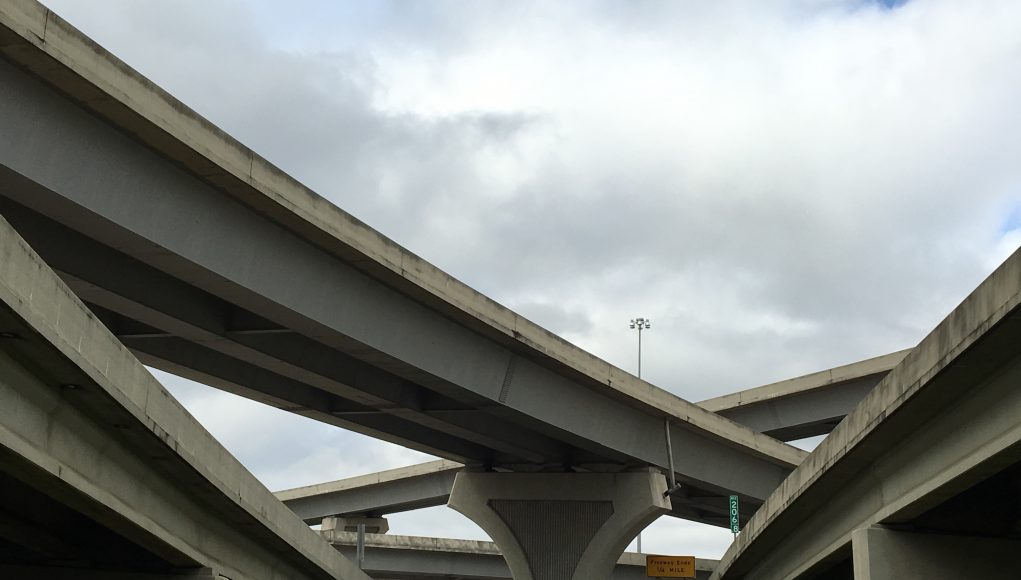Editor’s Note: The Shreveport City Council has postponed a vote on whether to adopt a resolution to support the building of an interstate connector to complete I-49 by cutting through Allendale which was scheduled for Tuesday, January 12. While the issue is tabled for now, Heliopolis encourages the citizens of Shreveport to read the article below and voice their opinions to their elected officials. Below is an explanation of the issue and the proposed solutions from both camps.
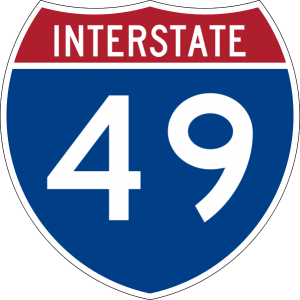 Shreveport, We Have a Problem
Shreveport, We Have a Problem
Shreveport has a north-south problem, in the form, or rather broken form, of Interstate-49.
As anyone who drives around Shreveport knows, I-49 has a gap in it. A rather awkward gap, as there isn’t a direct, logical route from where I-49 ends just south of downtown at its intersection with Interstate 20 to where it picks up again at the newly-completed leg at Martin Luther King, Jr. Boulevard a few miles north. Today, in order to complete a journey on I-49’s path, you must either drive twelve miles on Hwy. 3132 (the Inner Expressway Loop) or nine miles on Route 71, which goes through downtown Shreveport out to North Market Street.
If you take Route 71, the preferred route of Shreveport residents, there are no signs for the first half of the route telling you where to go to get to I-49. You just have to know that if you’re traveling north on I-49, you have to go to Spring Street downtown, which becomes North Market Street/Route 71, and follow the road for nine miles. You don’t see the first signs directing you to I-49 until after four miles, and they still don’t tell you how much farther you have to go.
If you aren’t planning to stop in Shreveport during your travels or you don’t want to drive on city streets, as is the case with most truck drivers, you might take 3132 Inner Expressway loop. You can go faster on 3132 than on Route 71, but the highway takes you out on Shreveport’s western rim before bringing you back to the I-49 connector on either side. The 3132 route adds about 12 minutes to your travel time, while Route 71 is between 15 and 20 minutes, depending on city traffic. Neither route is hugely inconvenient, but I-49’s gap and the lack of a direct connection between its two ends make Shreveport seem unfinished and behind the times.
Minding the Gap
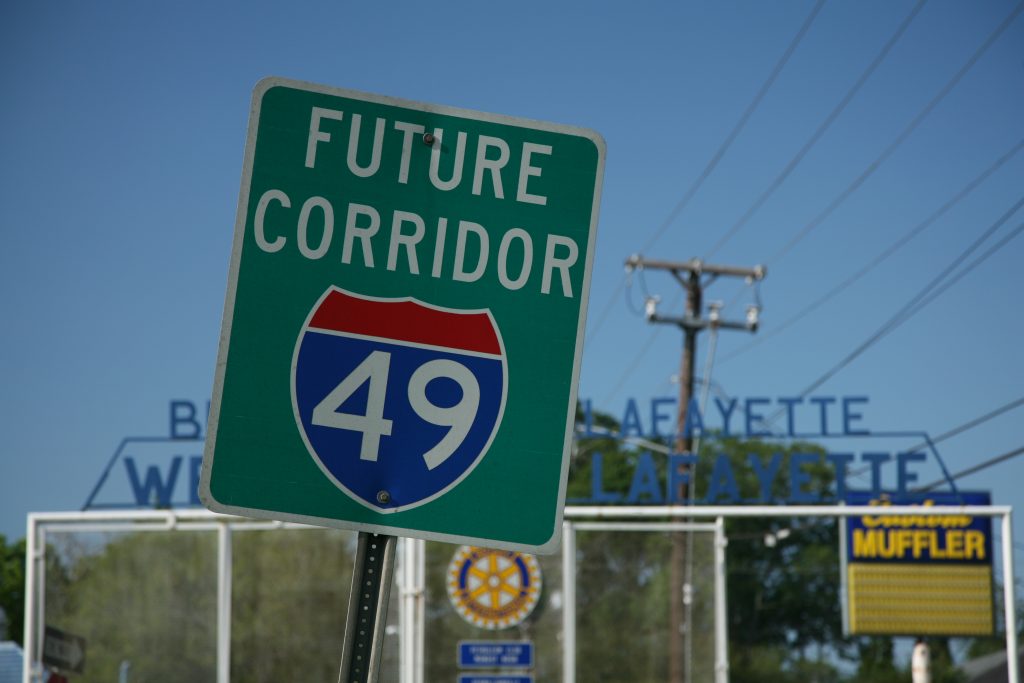
A proposal to connect I-49’s north and south ends with a direct route, then, seems like a simple, logical, and overdue solution. The North Louisiana Council of Governments (NLCOG), a regional planning council for economic development projects in the area, completed a feasibility study in 2010 on the building of a three-to-four mile Inner City Connector for I-49. As shown in NLCOG’s map, there are four proposed alternative versions of the Inner City Connector, but they all start from approximately the same point, running northwest from the I-49/I-20 intersection to an intersection with I-220, which would then take drivers to I-49. A fifth route is the “No Build” alternative, which, as the name implies, is to stay with the routes in place.
Filling in I-49’s gap by building an Inner City Connector is a much more complex and controversial issue than it appears on the surface. All four building alternatives of NLCOG’s proposed Connector consist of an elevated freeway that would cut through the historic black neighborhood of Allendale on the western edge of downtown. Citizens living in the path of the Connector would have to move, and their houses, businesses, churches, and all other structures in the way would be demolished. However, the consequences are even more far-reaching, according to an Allendale neighborhood group of residents and community activists, called “LOOP It.”
Proposal: Don’t Build in the City; Repurpose Instead
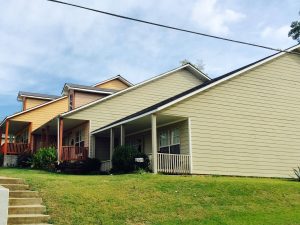
LOOP It predicts that an elevated freeway, the standard method of building an interstate through an urban area like the section of I-49 by Mall St. Vincent, would devastate the entire neighborhood of Allendale, not just the part that lies in the path of the freeway, and have far-reaching negative consequences for Shreveport as a whole. For the neighborhood, the Inner City Connector’s traffic would bring air and noise pollution into the neighborhood as well as be an eyesore, which would bring down property values and business revenue. Supporters of LOOP It believe that building through Allendale will cause home owners and businesses to move out.
Dorothy Wiley, the chair of LOOP It who moved to Allendale in 2005 after fleeing Hurricane Katrina, says that if NLCOG’s Inner City Connector is implemented it will destroy Allendale right at the time the neighborhood is being revitalized, with new houses being built and new businesses opening. The Fuller Center for Housing began building good, affordable housing in 2005 for homeless Hurricane Katrina refugees. Joined recently by Community Renewal International and volunteers, the Fuller Center has built about 50 homes. The Center also just opened The Fuller Grocery & Deli, the first grocery store offering fresh fruits and vegetables in what we at Heliopolis, among others, have declared a food desert. All this is happening when cities around the nation are seeing huge resurgences of city centers and surrounding communities.
John Perkins, a LOOP It member, calls the effect a “border vacuum.” He believes that an Inner City Connector would exacerbate city sprawl and further disrupt communities that the majority of eastern Shreveport sees as undesirable.
Kim Mitchell, an architect and planner who is working pro bono on behalf of Allendale residents to propose an alternative Inner City Connector, calls the building of interstates through cities “the biggest, if unintentional, mistake our country has made.” In a public meeting held last November, he spoke passionately about the destructive impact the building of interstates has had on Shreveport. “If you could begin to connect the dots that led to the deterioration of our inner city,” Mitchell said, “it started with the building of I-20.”
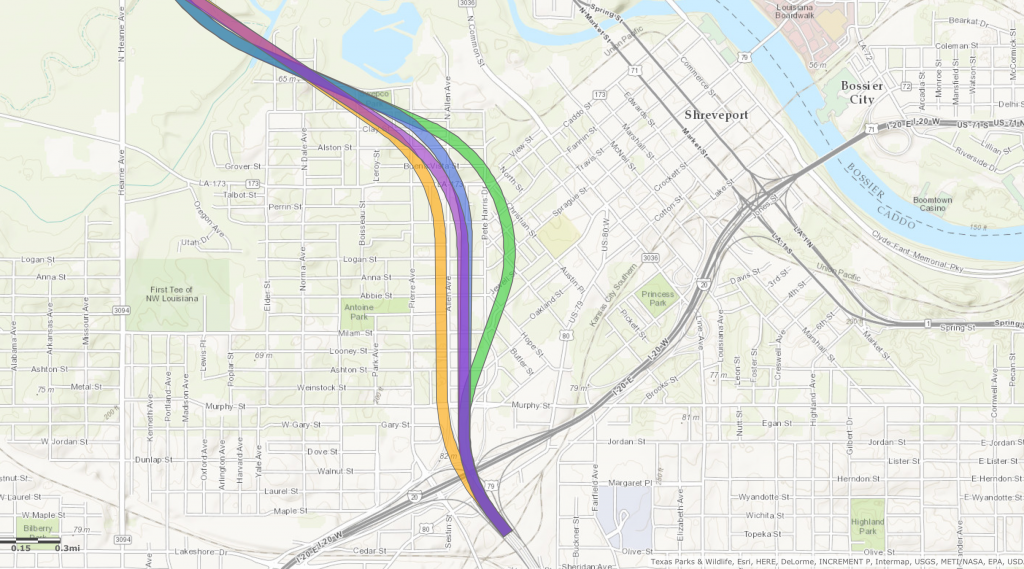
Proposal: Build in the City, Straight through the Heart
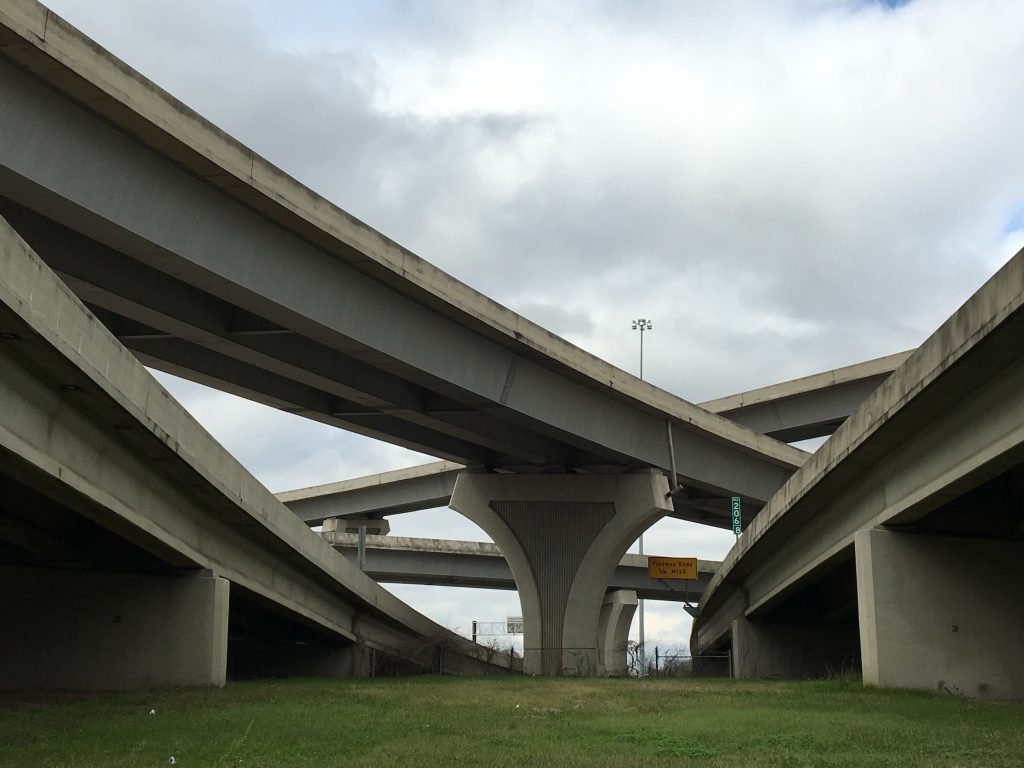
On the flip side, proponents of the Inner City Connector insist NLCOG’s plan will have the opposite effect of what LOOP It fears: it will be an economic boon to the city and to Allendale in particular. Patrick Harrison, president of Sound Fighter Systems, which manufactures sound-absorptive sound walls often placed along highways to muffle traffic noise, said the connector will “definitely be a positive economic development. That just happens from building a highway.” He and other business leaders foresee gas stations, retail shops and fast food restaurants built along the proposed Inner City Connector, bringing drivers near Shreveport’s downtown, which will lead to businesses moving into the area.
Harrison also believes building the Inner City Connector will ultimately improve Allendale, which went into decline after the gas and oil industry dried up in the early 1980s. “There were a lot of drugs and gang violence,” he said. “The area has never really recovered.” He added that he thought the people opposed to building the Inner City Connector were doing the Allendale residents a disservice by keeping them from the chance to have a better quality of life. “People who live in the planned path of the Inner City Connector can move to a better area of Shreveport,” Harrison explained, “and the ones who remain in Allendale will benefit from the economic growth the highway will bring.” Providence Engineering, a Baton Rouge consulting group hired by NLCOG, has conducted an environmental and economic impact study for NLCOG’s Planning and Environmental Stage of the I-49 connector project (Stage 1), but has not yet officially released its cost and economic impact numbers.
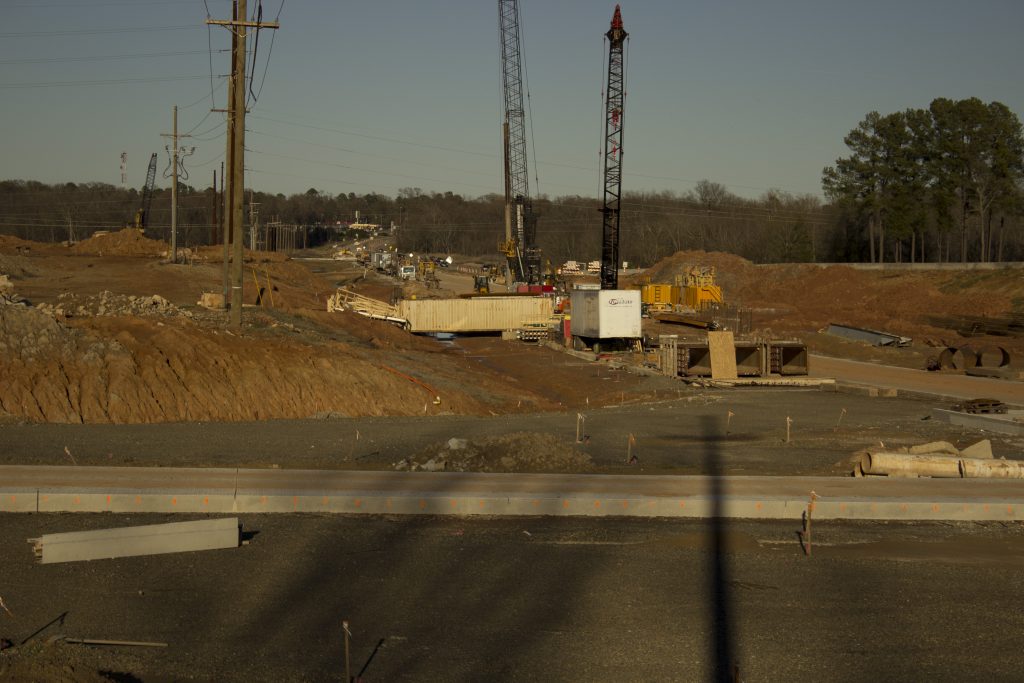
Supporters of the Inner City Connector have claimed that LOOP It’s plan to keep using Hwy. 3132 to loop I-49 drivers around the city will be very costly, as the route would need to be upgraded to interstate standards. “It will have to be made into a real part of the interstate, which doesn’t just mean putting up I-49 signs,” Harrison said. “It will be a tremendous, expensive undertaking.” One of the interstate upgrades would be expanding 3132’s four lanes (with two lanes going in each direction) to six lanes (three lanes in each direction), including the bridge that goes over Cross Lake. NLCOG has estimated upgrading 3132 will cost about $1.2 billion. NLCOG has determined that the continuing use of Hwy. 3132 to loop I-49 traffic is the fifth “No Build” alternative in NLCOG’s I-49 project.
Mitchell of LOOP It points out that the “No Build” alternative is also supposed to be “no cost.” The estimated $1.2 billion cost goes against the National Environmental Protection Act requirement that there be a no-build/no-cost alternative. Mitchell also believes NLCOG has attempted to confuse LOOP It’s position by associating their proposal to continuing using Hwy. 3132 to loop traffic around Shreveport with the “No Build” alternative. He says NLCOG has willfully ignored the other part of their proposal.
A Third Option
While LOOP It does not want the elevated I-49 connector to cut through Allendale, Wiley maintains that they are not opposed to a ponnector plan for I-49. The group has proposed having a ground-level I-49 Inner City Connector in the form of a mixed-use Business Route Boulevard for local traffic, while the existing I-220 and Hwy. 3132 would be used by through traffic. This Business Route Boulevard would be a re-purposing of the two existing methods of connecting I-49’s missing pieces and making them official. North Market/Route 71 would be dedicated to local traffic – often called a Business Route around the country – and heavy truck and through traffic would continue to use Highway 3132. Then, it is speculated, we wouldn’t have to upgrade either route because they wouldn’t have to support a higher volume of traffic. The Business Route Boulevard would become part of I-49, just as NLCOG’s proposed Inner City Connector would, and Hwy. 3132 would not be the I-49 connector and would therefore not need to be upgraded.
LOOP It envisions Shreveport reinvesting in North Market Street/Route 71 to develop a Business Route Boulevard and have it connect the two ends of I-49, which they say would be much less expensive than building a whole new freeway segment. Mitchell estimates that upgrading Market Street/Route 71 will cost only $60 million from developing the business boulevard while yielding over $900 million in economic and social gain. “[Separating] through traffic from local traffic is an urban design that has proven to be successful across the country,” Mitchell says.
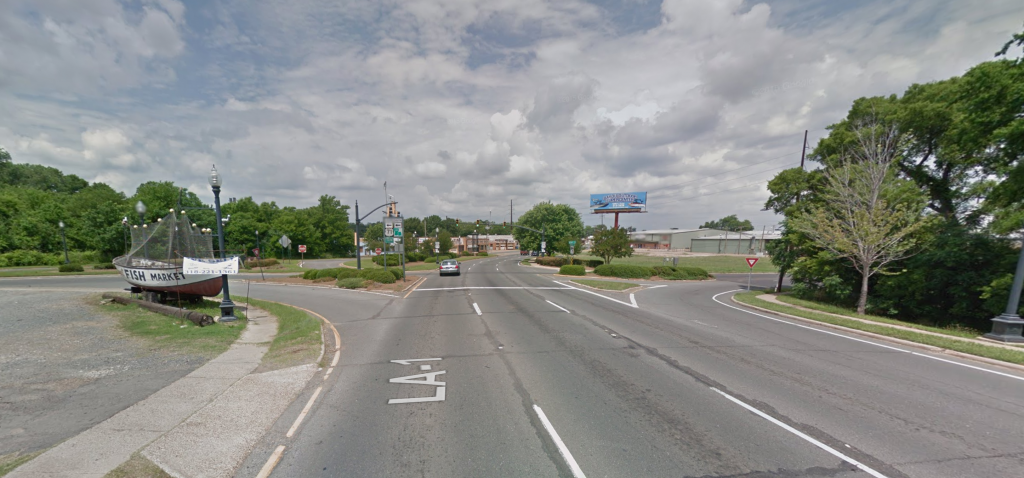
Plans with Precedents
And the idea is far from without merit. For one, a dual set-up of local and through traffic conduits often reduces congestion and pollution, which have proven to dampen economic development, in the area as a whole and in the inner city. Second, drivers on the Business Route Boulevard travel at slower speeds than they would on an expressway, which makes them much more likely to stop at stores, restaurants, parks, and other businesses along the route. Perkins and Mitchell say drivers on an elevated expressway do not usually want to stop unless they have to — for gas, fast food, or a bathroom break. If they do stop, they wouldn’t have a different experience than when they pull off of an interstate somewhere else in the country. But if drivers stop at local businesses or parks along a business boulevard, they are more likely to have a more memorable, and ideally positive, experience that will make them want to come back to Shreveport — a model that they claim promises a much greater economic gain for the city than the elevated Inner City Connector.

The trend today is for cities to dismantle their inner city freeways. Perkins points to the numerous cities that have either done so or are starting to: Chattanooga, Milwaukee, Oklahoma City, Dallas, Houston, and Austin — even Seoul, South Korea. Instead, Perkins says cities are using the “more permeable, multi-use routes such as boulevards and parkways,” which often revitalize neighborhoods along or near these types of roadways. He adds that millennials are less interested in always having to rely on cars to get around and are embracing urban areas in which they can walk or bike easily to work, stores, and restaurants, such as Portland, Oregon.
LOOP It leaders think building an Inner City Connector is a moot point anyway, because there aren’t the funds to do it. John Perkins says Louisiana has billions of dollars in backlogged interstate repairs and upgrades, without the money to do it. He and Kim Mitchell argue the federal government no longer pays 90% of interstate construction, with the state covering the remaining amount, as it did in the past; at the most, the government covers 40% of the cost. NLCOG has estimated building the 3.6 mile Inner City Connector would cost about $350 million, while Loop It has estimated $500 million. Patrick Harrison maintains there will be money to build the Inner City Connector if the city decides it needs it. “All the major business groups want to see this connector built — the Shreveport Chamber of Commerce, the Bossier Chamber of Commerce, the Committee of 100,” he said. “We will find a way to build the connector.”
So, which makes sense to you? Where do you stand? Your voice is important in this fork in the road for Shreveport. A brand new elevated Inner City Corridor that will rip thru Allendale, but perhaps create gas stations and hotels on downtown’s outer rim? Or the alternative – a less expensive Business Route Boulevard approach using existing pathways with a goal of revitalization?
Stay informed on this important issue!
The LOOP It Allendale Neighborhood Group meets the second Thursday of each month at 6:30 p.m. at the Allendale Friendship House, 1515 Clay Street. Dorothy Wiley invites all those who are interested in learning about the Allendale community and how this important issue will affect the community’s future. You can also visit LOOP It’s page on Facebook and a new Facebook group, 1000 Friends of Allendale Neighborhood.
This month, NLCOG will host a third round of public input meetings January 19–21, 2016, to provide information on specific possible corridors for an I-49 Inner City Connector as part of their Stage 1 study.
Tuesday, January 19, 2016
Shreveport Chamber of Commerce
400 Edwards Street
11:00 a.m.—1:00 p.m.
Hamilton-South Caddo Branch Library
2111 W. Bert Kouns Industrial Loop
6:00 p.m.—8:00 p.m.
Wednesday, January 20, 2016
Galilee Missionary Baptist Church
1500 Pierre Avenue
11:00 a.m.—1:00 p.m.
Shreveport Convention Center
400 Caddo Street
6:00 p.m.—8:00 p.m.
Thursday, January 21, 2016
Louisiana Technical College – Shreveport-Bossier Campus
2010 N. Market Street
11:00 a.m.—1:00 p.m.
Mt. Canaan Baptist Church
1666 Alston Street
6:00 p.m. – 8:00 p.m.
For further questions about the current status of the project, visitwww.i49shreveport.com or www.nlcoglistens.com. You can also visit Thru the City’s Facebook page.

